HONDA CR-Z 2012 1.G User Guide
Manufacturer: HONDA, Model Year: 2012, Model line: CR-Z, Model: HONDA CR-Z 2012 1.GPages: 333, PDF Size: 10.43 MB
Page 11 of 333
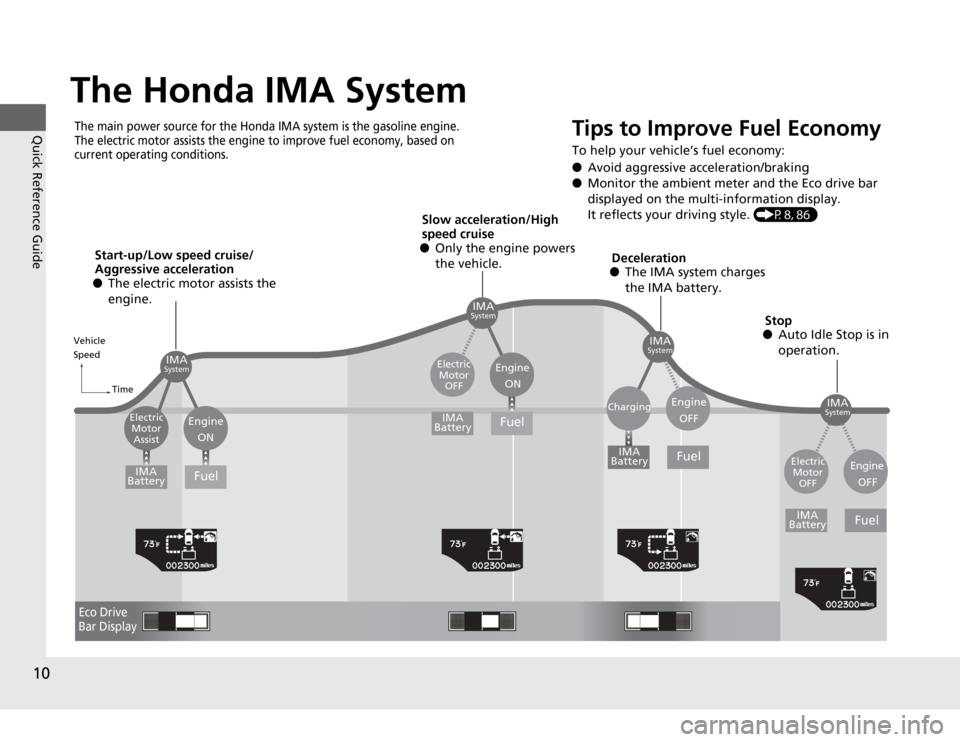
10
Quick Reference Guide
The Honda IMA System
The main power source for the Honda IMA system is the gasoline engine.
The electric motor assists the engine to improve fuel economy, based on
current operating conditions.Tips to Improve Fuel Economy
To help your vehicle’s fuel economy: ● Avoid aggressive acceleration/braking
● Monitor the ambient meter and the Eco drive bar
displayed on the multi-information display.
It reflects your driving style. (P8, 86)
Start-up/Low speed cruise/
Aggressive acceleration
● The electric motor assists the engine.
Slow acceleration/High speed cruise
● Only the engine powers the vehicle. Deceleration
● The IMA system charges the IMA battery.
Stop
● Auto Idle Stop is in
operation.
Vehicle Speed
Time
Eco Drive
Bar Display
IMA
System IMA
System
IMA
System
IMA
System
Electric
Motor
Assist Engine
ON Electric
Motor
OFF
Charging
Engine
ON
Engine
OFF
Engine
OFF
IMA
Battery IMA
Battery
IMA
Battery
IMA
Battery
Fuel Fuel
Fuel
Fuel
Electric Motor OFF
Page 12 of 333
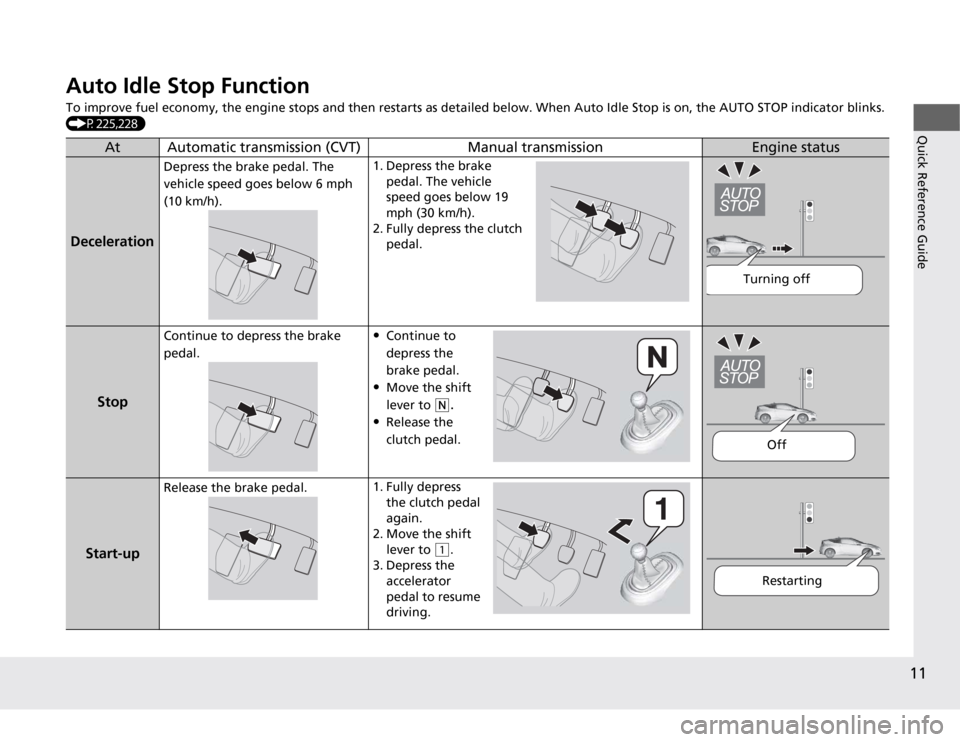
11
Quick Reference Guide
Auto Idle Stop Function
To improve fuel economy, the engine stops and then restarts as detailed below. When Auto Idle Stop is on, the AUTO STOP indicator blinks.
(P225,228)
AtAutomatic transmission (CVT)Manual transmissionEngine status
Deceleration Depress the brake pedal. The
vehicle speed goes below 6 mph
(10 km/h).
1. Depress the brake
pedal. The vehicle
speed goes below 19 mph (30 km/h).
2. Fully depress the clutch pedal.
Stop
Continue to depress the brake pedal.•Continue to depress the
brake pedal.
• Move the shift lever to
(N.
• Release the
clutch pedal.
Start-up Release the brake pedal.
1. Fully depress
the clutch pedal
again.
2. Move the shift lever to (1 .
3. Depress the
accelerator pedal to resume
driving.
Turning off
Off
Restarting
Page 13 of 333
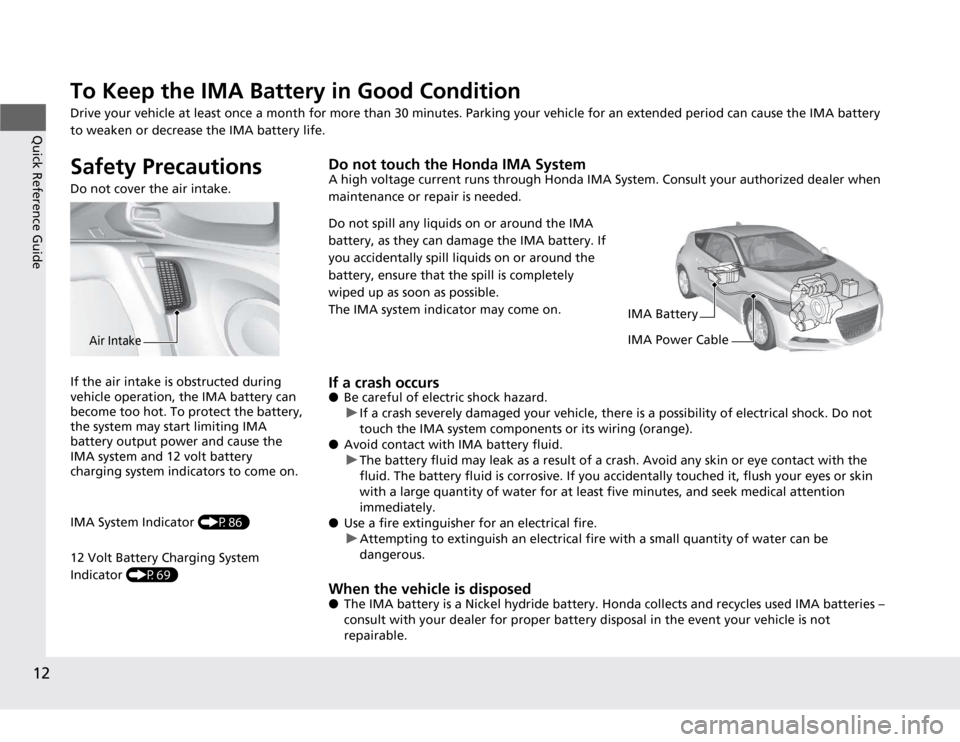
12
Quick Reference Guide
To Keep the IMA Battery in Good Condition
Drive your vehicle at least once a month for more than 30 minutes. Parking your vehicle for an extended period can cause the IMA battery
to weaken or decrease the IMA battery life. Safety Precautions
Do not cover the air intake.
Air Intake
Do not touch the Honda IMA System
A high voltage current runs through Honda IMA System. Consult your authorized dealer when
maintenance or repair is needed.
Do not spill any liquids on or around the IMA
battery, as they can damage the IMA battery. If
you accidentally spill liquids on or around the
battery, ensure that the spill is completely
wiped up as soon as possible.
The IMA system indicator may come on.
IMA Battery
IMA Power Cable
If a crash occurs ● Be careful of electric shock hazard.
uIf a crash severely damaged your vehicle, there is a possibility of electrical shock. Do not
touch the IMA system components or its wiring (orange).
● Avoid contact with IMA battery fluid.
uThe battery fluid may leak as a result of a crash. Avoid any skin or eye contact with the
fluid. The battery fluid is corro sive. If you accidentally touched it, flush your eyes or skin
with a large quantity of water for at least five minutes, and seek medical attention
immediately.
● Use a fire extinguisher for an electrical fire.
uAttempting to extinguish an electrical fire with a small quantity of water can be dangerous.
When the vehicle is disposed ● The IMA battery is a Nickel hydride battery. Honda collects and recycles used IMA batteries –
consult with your dealer for proper batter y disposal in the event your vehicle is not
repairable.
If the air intake is obstructed during
vehicle operation, the IMA battery can
become too hot. To protect the battery,
the system may start limiting IMA
battery output power and cause the IMA system and 12 volt battery
charging system indicators to come on.
IMA System Indicator
(P86)
12 Volt Battery Charging System Indicator (P69)
Page 14 of 333
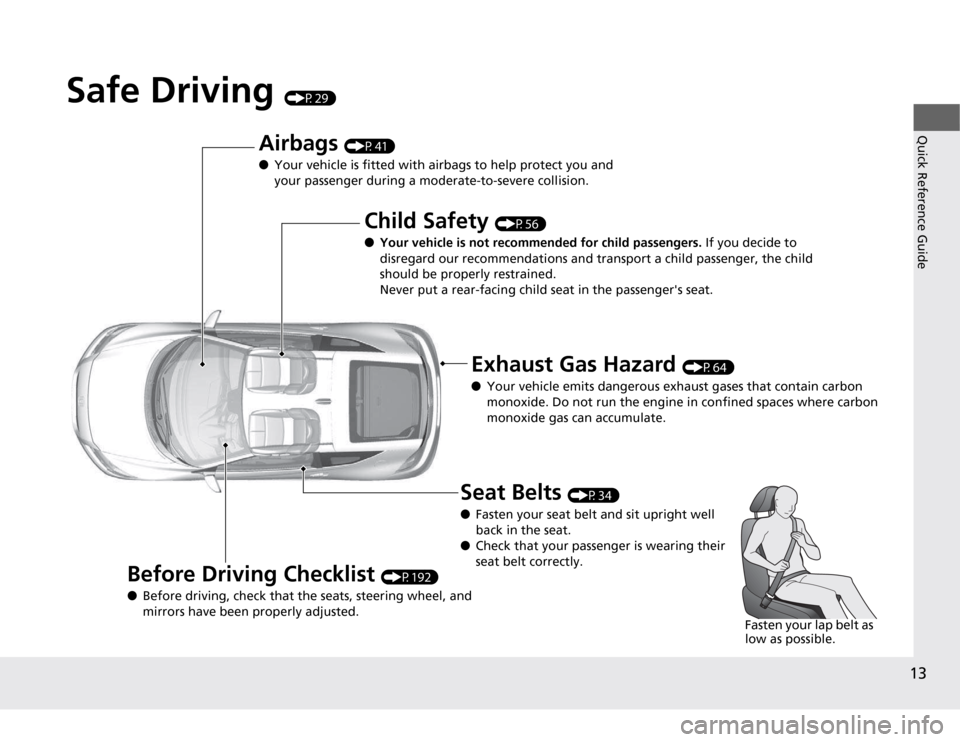
13
Quick Reference Guide
Safe Driving (P29)
Airbags (P41)
● Your vehicle is fitted with airbags to help protect you and
your passenger during a moderate-to-severe collision.
Child Safety (P56)
● Your vehicle is not recommended for child passengers. If you decide to
disregard our recommendations and transport a child passenger, the child
should be properly restrained.
Never put a rear-facing child seat in the passenger's seat.
Exhaust Gas Hazard (P64)
● Your vehicle emits dangerous exhaust gases that contain carbon
monoxide. Do not run the engine in confined spaces where carbon
monoxide gas can accumulate.
Before Driving Checklist (P192)
● Before driving, check that the seats, steering wheel, and
mirrors have been properly adjusted. Seat Belts
(P34)
● Fasten your seat belt and sit upright well back in the seat.
● Check that your passenger is wearing their
seat belt correctly.
Fasten your lap belt as
low as possible.
Page 15 of 333
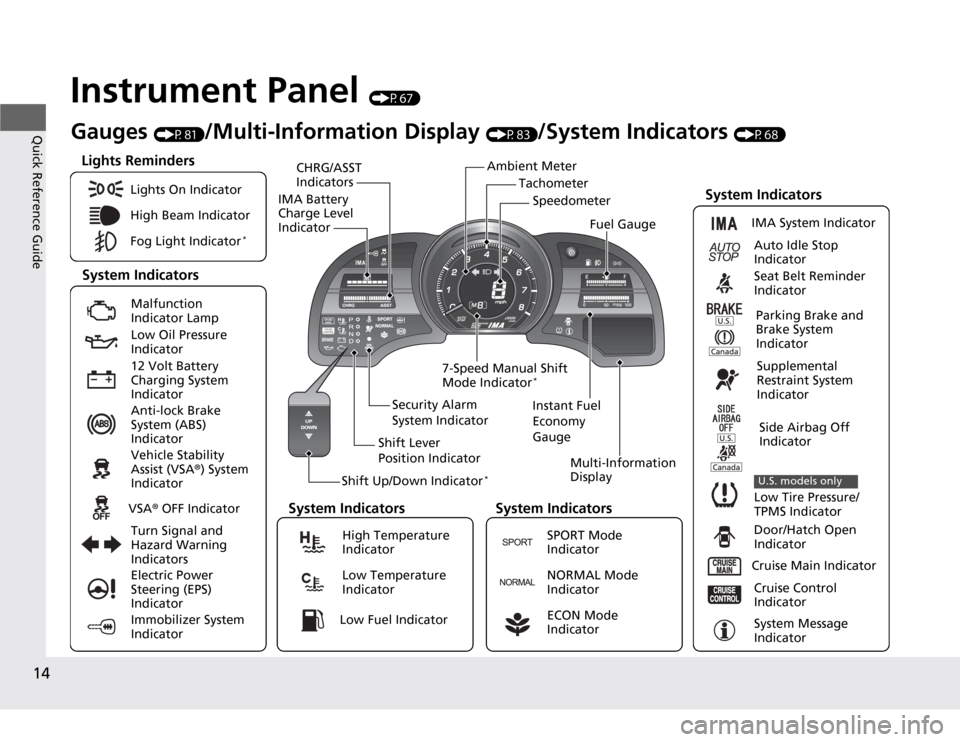
14
Quick Reference Guide
Instrument Panel (P67)
Tachometer
CHRG/ASST Indicators
IMA Battery Charge Level Indicator
Shift Up/Down Indicator *Multi-Information
Display
7-Speed Manual Shift Mode Indicator
*
System Indicators
Lights Reminders
Instant Fuel
Economy GaugeSpeedometer
Fuel Gauge
Security Alarm
System Indicator
Shift Lever
Position Indicator
Gauges
(P81)/Multi-Information Display (P83)/System Indicators (P68)
Ambient Meter
System Indicators System Indicators
System IndicatorsLights On Indicator
High Beam Indicator
Fog Light Indicator *
Malfunction
Indicator Lamp
Low Oil Pressure Indicator
12 Volt Battery
Charging System Indicator
Anti-lock Brake
System (ABS) Indicator
Vehicle Stability Assist (VSA
®) System
Indicator
VSA ® OFF Indicator
Turn Signal and
Hazard Warning
Indicators
Electric Power Steering (EPS) Indicator
Immobilizer System Indicator
IMA System Indicator
Auto Idle Stop
Indicator
Seat Belt Reminder
Indicator
Parking Brake and
Brake System
Indicator
Supplemental
Restraint System
Indicator
Side Airbag Off
Indicator
Low Tire Pressure/
TPMS Indicator
U.S. models only
Door/Hatch Open
Indicator
Cruise Main Indicator
Cruise Control
Indicator
System Message
Indicator
High Temperature Indicator
Low Temperature Indicator
SPORT Mode
Indicator
NORMAL Mode
Indicator
ECON Mode
Indicator Low Fuel Indicator
Page 16 of 333
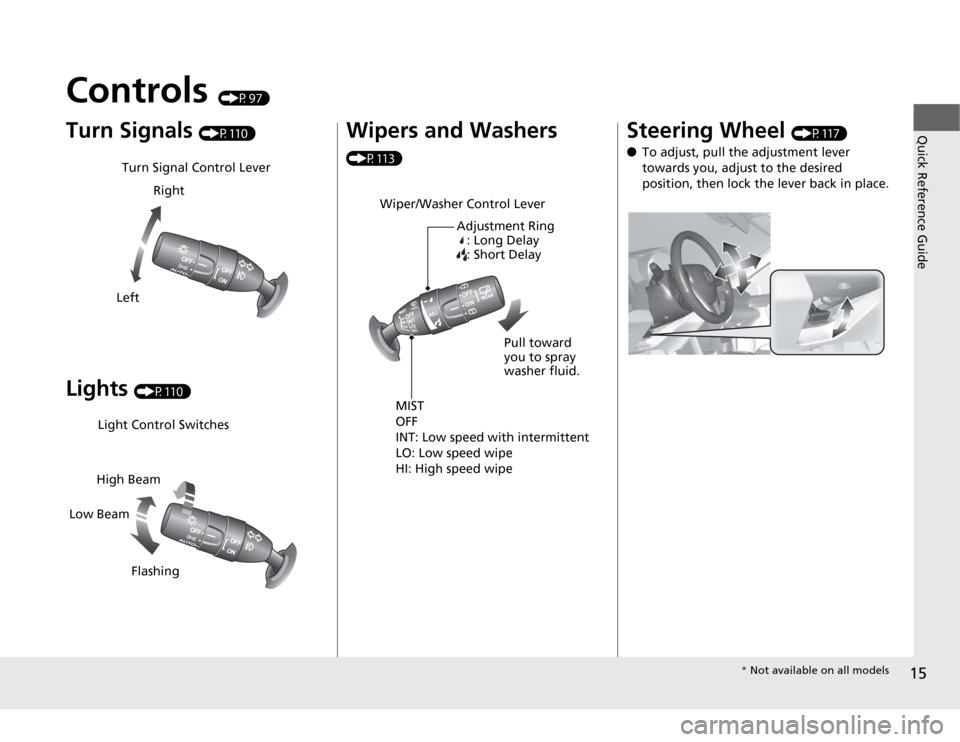
15
Quick Reference Guide
Controls (P97)
Turn Signals (P110)
Lights (P110)
Turn Signal Control Lever
Right
Left
Light Control Switches
Low Beam High Beam
Flashing Wipers and Washers
(P113)
Wiper/Washer Control Lever
Adjustment Ring: Long Delay
: Short Delay
MIST
OFF
INT: Low speed with intermittent
LO: Low speed wipe
HI: High speed wipe Pull toward you to spray
washer fluid.
Steering Wheel
(P117)
● To adjust, pull the adjustment lever
towards you, adjust to the desired
position, then lock the lever back in place.
* Not available on all models
Page 17 of 333
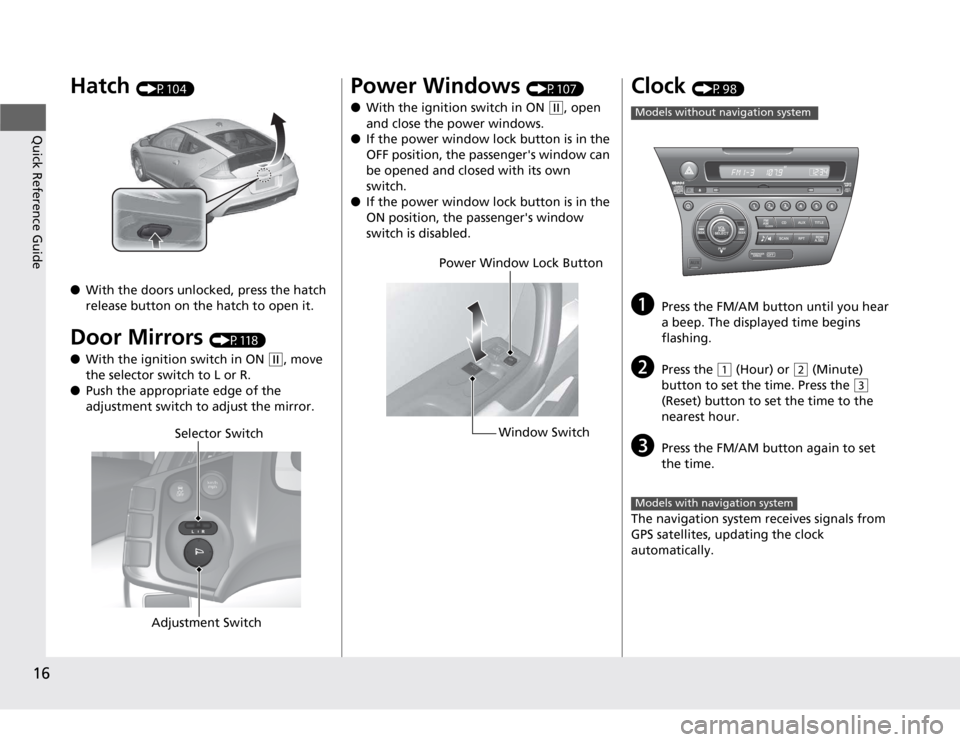
16
Quick Reference Guide
Hatch (P104)
● With the doors unlocked, press the hatch
release button on the hatch to open it.
Door Mirrors (P118)
● With the ignition switch in ON
(w, move
the selector switch to L or R.
● Push the appropriate edge of the
adjustment switch to adjust the mirror.
Selector Switch
Adjustment Switch
Power Windows (P107)
● With the ignition switch in ON
(w, open
and close the power windows.
● If the power window lock button is in the
OFF position, the passenger's window can
be opened and closed with its own switch.
● If the power window lock button is in the
ON position, the passenger's window
switch is disabled.
Power Window Lock Button
Window Switch
Clock (P98)
a Press the FM/AM button until you hear
a beep. The displayed time begins flashing.
b Press the
(1 (Hour) or (2 (Minute)
button to set the time. Press the
(3
(Reset) button to set the time to the nearest hour.
c Press the FM/AM button again to set the time.
The navigation system receives signals from
GPS satellites, updating the clock
automatically.
Models without navigation system
Models with navigation system
Page 18 of 333
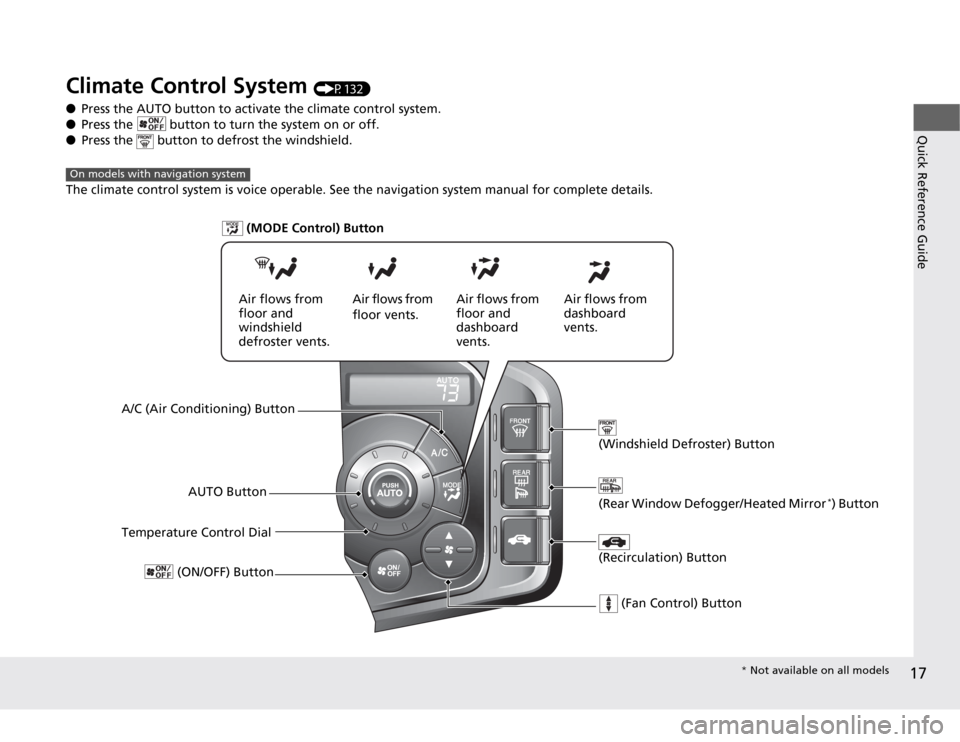
17
Quick Reference Guide
Climate Control System (P132)
● Press the AUTO button to activate the climate control system.
● Press the button to turn the system on or off.
● Press the button to defrost the windshield.
The climate control system is voice operable. See the navigation system manual for complete details.
On models with navigation system
AUTO Button
Temperature Control Dial (ON/OFF) Button
(Recirculation) Button
(Fan Control) Button
(Rear Window Defogger/Heated Mirror *
) Button
(Windshield Defroster) Button
A/C (Air Conditioning) Button (MODE Control) Button
Air flows from floor and
windshield
defroster vents.
Air flows from floor vents.
Air flows from
floor and
dashboard
vents. Air flows from
dashboard
vents.
*
Not available on all models
Page 19 of 333
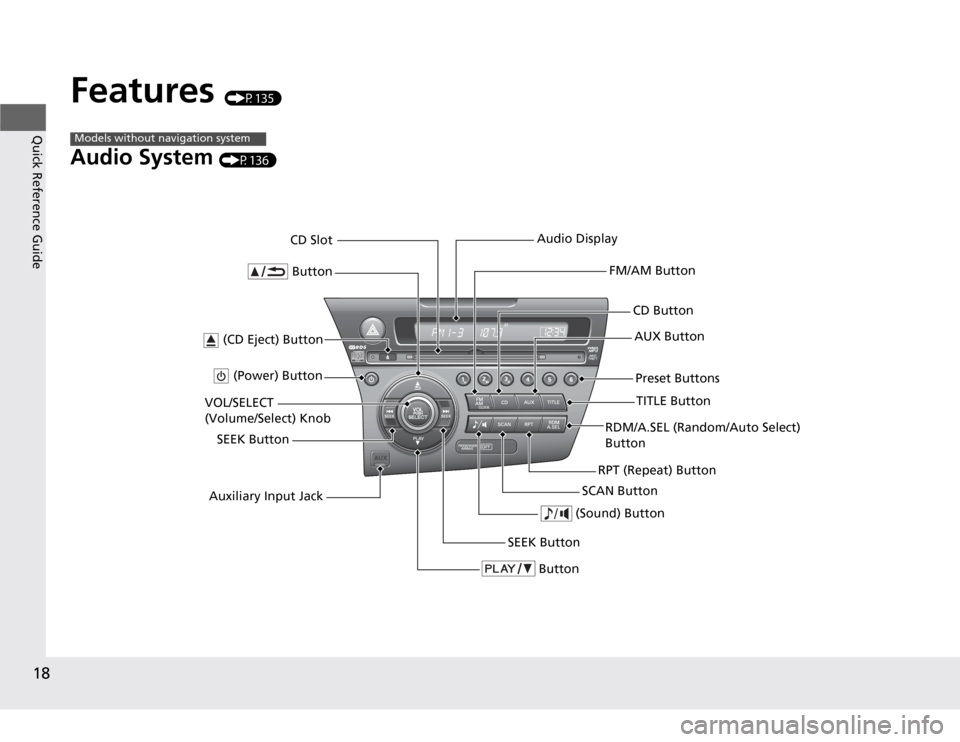
18
Quick Reference Guide
Features (P135)
Audio System (P136)
Models without navigation system
Button
TITLE Button
FM/AM Button
(Power) Button
CD Button AUX Button
CD Slot
(CD Eject) Button
SCAN Button
(Sound) Button
VOL/SELECT
(Volume/Select) Knob
SEEK ButtonPreset Buttons
Button
SEEK Button
Auxiliary Input Jack Audio Display
RDM/A.SEL (Random/Auto Select) Button
RPT (Repeat) Button
Page 20 of 333
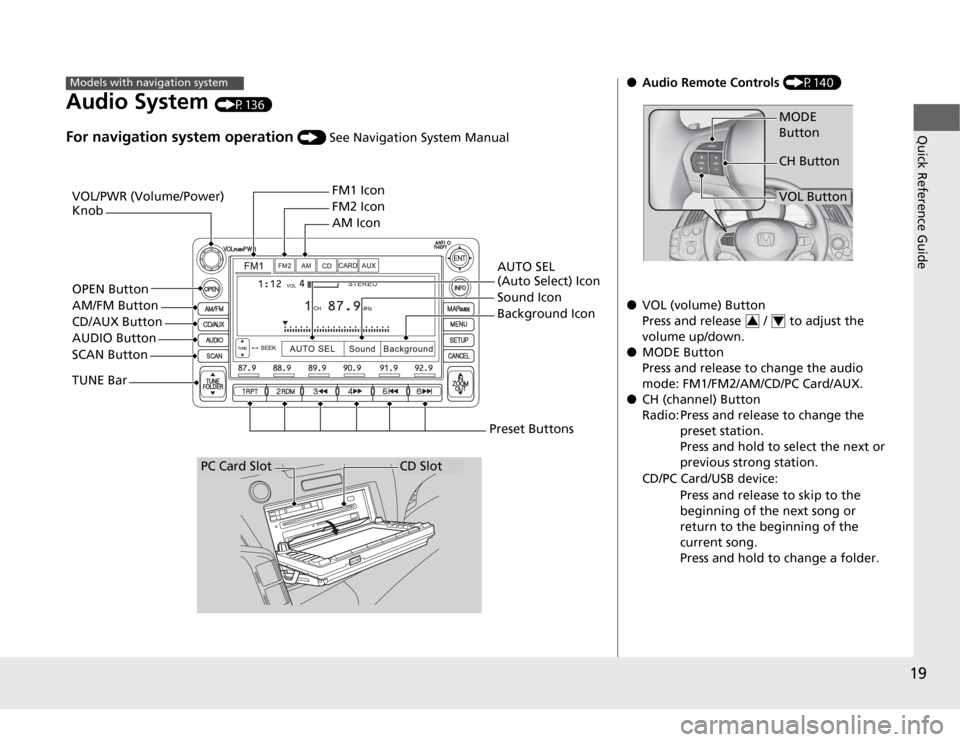
19
Quick Reference Guide
Audio System (P136)
For navigation system operation () See Navigation System Manual
Models with navigation system
VOL/PWR (Volume/Power) Knob FM1 Icon
FM2 Icon AM Icon
OPEN Button
AM/FM Button CD/AUX Button
AUDIO Button
SCAN Button
TUNE Bar AUTO SEL
(Auto Select) Icon
Sound Icon
Background Icon
Preset Buttons
CD SlotPC Card Slot
● Audio Remote Controls (P140)
● VOL (volume) Button
Press and release / to adjust the
volume up/down.
● MODE ButtonPress and release to ch ange the audio
mode: FM1/FM2/AM/CD/PC Card/AUX.
● CH (channel) Button
Radio: Press and release to change the
preset station.
Press and hold to select the next or
previous strong station.
CD/PC Card/USB device:
Press and release to skip to the
beginning of the next song or
return to the beginning of the
current song.
Press and hold to change a folder.
MODE Button
VOL Button
CH Button
34